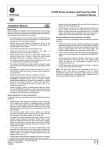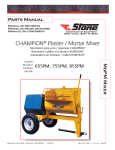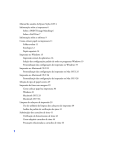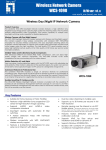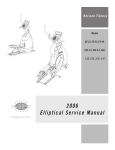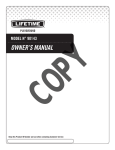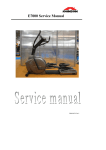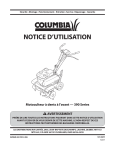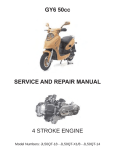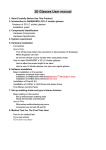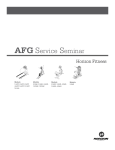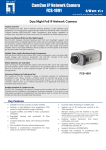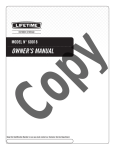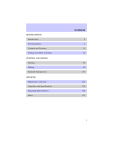Download 2006 Treadmill Service Manual
Transcript
H o r i z o n Fitness Models T61, T62, T63, T64, CST 3.5, CST 4.5, DT650, DT850, WT950, PST 6, PST 8, 1.2T, 2.2T, 3.2T, 4.2T, 5.2T 2006 Treadmill Service Manual Table of C ontents Warranty 3 Safety Instructions 4 Recommended Tools 6 Maintenance 7 Proper Heart Rate Usage 14 Horizon Fitness “5-Step” Diagnostic Process 16 Voltage Checks and LED Diagnosis 18 Wiring Diagrams and Schematics 22 Engineering Mode 31 Troubleshooting 34 Spare Parts Replacement 46 REFER TO THE SUPPLEMENTAL SHEET ON THE LAST PAGE OF THE SERVICE MANUAL FOR THE MID SEASON PRODUCTION CHANGE ON THE LOWER CONTROL BOARD. WARRANTY LIM I T E D H O M E - U S E WARRANTY SAFETY INSTRUCTIONS Horizon Fitness extends the following exclusive, limited warranty, which shall apply to the use of the device in the home, for residential, non-commercial purposes only. Any other use shall void this warranty. Horizon Fitness hereby offers the following limited warranties for the following components of the device, for the time period indicated: Elevation 7 Years 10 Years 12 Years 15 Years 7 Years 10 Years 12 Years 15 Years 20 Years 22 Years 25 Years 25 Years 25 Years 25 Years 25 Years 12 Years Frame Lifetime Lifetime Lifetime Lifetime Lifetime Lifetime Lifetime Lifetime Lifetime Lifetime Lifetime Lifetime Lifetime Lifetime Lifetime Lifetime RECOMMENDED TOOLS Motor 7 Years 10 Years 12 Years 15 Years 7 Years 10 Years 12 Years 15 Years 20 Years 22 Years 25 Years 25 Years 25 Years 25 Years 25 Years 12 Years MAINTENANCE Parts 1 Year 1 Year 1 Year 1 Year 1 Year 1 Year 1 Year 1 Year 1 Year 1 Year 2 Years 2 Years 2 Years 2 Years 2 Years 1 Year PROPER HEART REATE USAGE Labor 1 Year 1 Year 1 Year 1 Year 1 Year 1 Year 1 Year 1 Year 1 Year 1 Year 1 Year 1 Year 1 Year 1 Year 1 Year 1 Year 5-STEP DIAGNOSTIC PROCESS Model T61 T62 T63 T64 DT650 DT850 CST 3.5 CST 4.5 PST 6 PST 8 1.2T 2.2T 3.2T 4.2T 5.2T WT950 VOLTAGE CHECKS AND LED DIAGNOSIS Horizon Fitness warranties the frame, electronics, and parts against defects in workmanship and materials for the above warranty periods, so long as it remains in the possession of the original owner. Horizon Fitness shall cover the labor cost for the repair of the device for the above warranty periods, so long as the device remains in the possession of the original owner. TROUBLESHOOTING ENGINEERING MODE WIRING DIAGRAMS AND SCHEMATICS EXCLUSIONS AND LIMITATIONS This warranty applies only to the original owner and is not transferable. This warranty is expressly limited to the repair or replacement of a defective frame, electronic component, or defective part. The warranty does not cover normal wear and tear, improper assembly or maintenance, or installation of parts or accessories not originally intended or compatible with the treadmill as sold. The warranty does not apply to damage or failure due to accident, abuse, corrosion, discoloration of paint or plastic, or neglect. Horizon Fitness shall not be responsible for incidental or consequential damages. All returns must be pre-authorized by Horizon Fitness. Horizon Fitness’ obligation under this warranty is limited to replacing or repairing, at Horizon Fitness’ option, the product at one of its authorized service centers. A Horizon authorized service center must receive all products for which a warranty claim is made. These products must be received with all freight and other transportation charges prepaid, accompanied by sufficient proof of purchase. Parts and electronic components reconditioned to As New Condition by Horizon Fitness or its vendors may sometimes be supplied as warranty replacement parts and constitute fulfillment of warranty terms. This warranty gives you specific legal rights, and your rights may vary from state to state. SPARE PARTS REPLACEMENT WARRANTY REGISTRATION Your warranty card must be completed and sent to Horizon Fitness or register on line at www.horizonfitness.com, before a warranty claim can be processed. Im p o r t a n t S a f e t y I n s t r u c t i o n s WARRANTY Warning statements indicate a particularly dangerous activity. You should be extremely cautious when doing the following: SAFETY INSTRUCTIONS • Removing power from the treadmill, or removing the power cord from the wall outlet. Always ensure that the treadmill is unplugged from the wall outlet when you inspect or adjust the treadmill, or when you isolate, remove, or replace a treadmill component. • Removing the motor cover exposes high voltage components and potentially dangerous machinery. Exercise extreme caution when you perform maintenance procedures with the motor cover removed. • During service operations you will be very close to moving machinery and high voltage components. When you perform maintenance procedures with the hood removed, remove jewelry (especially from ears and neck), tie up long hair, remove neckties, and do not wear loose clothing. • When the treadmill is operating, the capacitor will hold a lethal amount of charge. Do not touch the capacitor as serious injury or death might result. • When the treadmill is turned off and the power cord is removed from the wall outlet, the capacitor will hold voltage for 30-60 seconds. Allow the capacitor to discharge for a period of one minute before you touch or work near the capacitor. Do not attempt to discharge the capacitor by any other means. • Exercise caution when touching any wire or electrical component during treadmill operation. • When it is necessary to lift the treadmill, ensure that the treadmill has adequate support. Do not lift the treadmill by the front. RECOMMENDED TOOLS MAINTENANCE PROPER HEART RATE USAGE 5-STEP DIAGNOSIS PROCESS Safety guidelines you should know and follow include: VOLTAGE CHECKS AND LED DIAGNOSIS WIRING DIAGRAMS AND SCHEMATICS ENGINEERING MODE TROUBLESHOOTING SPARE PARTS REPLACEMENT • Read the owner’s manual and follow all operation instructions. • Operate the treadmill on a solid, level surface. Locate the rear of the treadmill at least four feet from walls or furniture. Keep the area behind the treadmill clear. • Visually check the treadmill before beginning service or maintenance operations. If it is not completely assembled or is damaged in any way, exercise extreme caution while operating and checking the treadmill. • When operating the treadmill, do not wear loose clothing. Do not wear shoes with heels or leather soles. Check the soles of your shoes and remove any embedded stones. Tie long hair back. • Use care when getting on or off the treadmill. Use the handrails whenever possible. Do not get on or off the treadmill when the running belt is moving. • Before starting the running belt, straddle the belt by placing your feet firmly on the guiderails of the treadmill. You should also step off the belt and onto the guiderails of the treadmill after turning off the running belt. • Do not rock the unit. Do not stand or climb on the handrails, electronic console, or motor cover. • Do not set anything on the handrails, electronic console, or motor cover. Never place liquids on any part of the treadmill. • To prevent electrical shock, keep all electrical components, such as the drive motor, power cord, and circuit breaker away from water and other liquids. • Do not use accessory attachments that are not recommended by the manufacturer-such attachments might cause injuries. • Turn off the treadmill when adjusting or working near the rear roller. Do not make any adjustments to the running belt when someone is standing on the machine. • Keep all loose items away from the treadmill running surface. A treadmill running belt will not stop immediately if an object becomes caught in the belt or rollers. Connect this appliance to a properly grounded, dedicated 20-amp outlet only. See grounding Instructions. WARRANTY WARNING (SPVOEFE0VUMFU RECOMMENDED TOOLS MAINTENANCE Improper connection of the equipment-grounding conductor can result in a risk of electric shock. Check with a qualified electrician if you are in doubt as to whether the product is properly grounded. Do not modify the plug provided with the product, if it will not fit in the outlet; have a proper outlet installed by a qualified electrician. Figure 1 PROPER HEART REATE USAGE WARNING SAFETY INSTRUCTIONS GROUNDING INSTRUCTIONS This product must be grounded. If a treadmill should malfunction or breakdown, grounding provide a path of least resistance for electrical current to reduce the risk of electrical shock. This product is equipped with a cord having an equipment-grounding conductor and a grounding plug. The plug must be plugged into an appropriate outlet that is properly installed and grounded in accordance with local codes and ordinances. "EBQUFS 5"4'PS (SPVOEJOH4DSFX WIRING DIAGRAMS AND SCHEMATICS (SPVOEFE0VUMFU#PY VOLTAGE CHECKS AND LED DIAGNOSIS (SPVOEJOH1JO 5-STEP DIAGNOSTIC PROCESS .FUBM4DSFX SPARE PARTS REPLACEMENT TROUBLESHOOTING ENGINEERING MODE SAFETY TIPS • Never use the treadmill before securing the safety tether clip to your clothing. • If you experience chest pains, nausea, dizziness, or shortness of breath, stop exercising immediately and consult your physician before continuing. • Do not wear clothes that might catch on any part of the treadmill. • Keep power cord away from heated surfaces. • Keep children off of treadmill at all times. • Do not use treadmill outdoors. • Unplug treadmill before moving it. • Do not remove the treadmill motor cover or roller covers. • Treadmill should be plugged into a dedicated 20 amp circuit for optimal performance. Re q u i r e d To o l s a n d E q u i p m e n t WARRANTY The following list is a summary of the tools and equipment required by the procedures in this manual. Tools are not supplied by Horizon Fitness. SAFETY INSTRUCTIONS RECOMMENDED TOOLS MAINTENANCE PROPER HEART RATE USAGE 5-STEP DIAGNOSIS PROCESS VOLTAGE CHECKS AND LED DIAGNOSIS WIRING DIAGRAMS AND SCHEMATICS ENGINEERING MODE • Phillips screwdrivers • Anti-static wrist strap (when handling electronic parts) • Flat-head screwdrivers • Digital multi-meter • Drive belt tension gauge • Allen wrench set (Metric) • Open-end wrenches of assorted sizes (Metric) • Clamp-on amp meter • 1⁄2” drive ratchet and sockets of assorted sizes • Blue Thread Lock • Cable ties • Motor commutator stone • Needle nose pliers • Damp cloth • Rubber mallet • Drop cloth • Ruler • Snap ring pliers • Wire cutters TROUBLESHOOTING Note: The motor commutator stone can be ordered from Horizon Fitness. SPARE PARTS REPLACEMENT WARRANTY Preventativ e M a i n t e n a n c e P r o c e d u r e s Cleanliness of your Horizon Fitness treadmill and its operating environment will keep maintenance problems and service calls to a minimum. For this reason, Horizon Fitness recommends that the following SAFETY INSTRUCTIONS preventive maintenance schedule be followed. After Each Use WARNING RECOMMENDED TOOLS • Turn off the treadmill with the on/off switch, and unplug the power cord from the wall outlet. To remove power from the treadmill, the power cord must be disconected from the wall outlet. MAINTENANCE • Wipe down the running belt, deck, motor cover, and console casing with a damp cloth. Never use • Inspect the power cord. If the power cord is damaged, contact Horizon Fitness. • Make sure the power cord is not underneath the treadmill or in any other area where it can become PROPER HEART REATE USAGE solvents, as they can cause damage to the treadmill. pinched or cut. • Check the tension and alignment of the running belt. Make sure that the treadmill belt will not 5-STEP DIAGNOSTIC PROCESS damage any other components on the treadmill by being misaligned. VOLTAGE CHECKS AND LED DIAGNOSIS Every Week • Turn off the treadmill with the on/off switch. • Unplug the power cord at the wall outlet. • Fold the treadmill into the upright position; making sure that the foot lock latch is secure. • Move the treadmill to a remote location. • Wipe or vacuum any dust particles or other objects that may have accumulated underneath the WIRING DIAGRAMS AND SCHEMATICS Clean underneath the treadmill, following these steps: ENGINEERING MODE treadmill. • Return the treadmill to its previous position. TROUBLESHOOTING Every Month • Inspect all assembly bolts of the machine for proper tightness. • Add lubrication to deck and running belt. Use lubrication provided by Horizon Fitness only! • Lubricate the air shocks with a Teflon based spray. SPARE PARTS REPLACEMENT Each 3-6 months Te n s i o n i n g t h e R u n n i n g B e l t WARRANTY If you can feel a slipping sensation when running on the treadmill, the running belt must be tight- SAFETY INSTRUCTIONS ened. In most cases, the belt has stretched from use, causing the belt to slip. This is a normal and common adjustment. Make sure that the unit is turned off and not running. To eliminate this slipping, tension both the rear roller bolts with the appropriate sized Allen wrench, turning both the left and right bolt 1/4 TURN as RECOMMENDED TOOLS shown below. Try the treadmill again to check for slipping. Repeat if necessary, but NEVER TURN the roller bolts more than 1/4 turn at a time. MAINTENANCE PROPER HEART RATE USAGE Figure 2 5-STEP DIAGNOSIS PROCESS VOLTAGE CHECKS AND LED DIAGNOSIS WIRING DIAGRAMS AND SCHEMATICS ENGINEERING MODE 5FOTJPOJOH5IF3VOOJOHCFMU TROUBLESHOOTING SPARE PARTS REPLACEMENT WARRANTY Aligining th e R u n n i n g B e l t 1) If the running belt moves rapidly to one side when performing the next step, press the Stop button SAFETY INSTRUCTIONS immediately. • Turn on the treadmill. With the treadmill speed between 6-8 mph, stand behind the treadmill and watch the RECOMMENDED TOOLS movement of the running belt. As you watch the running belt, make sure that the belt runs without moving MAINTENANCE from one side to the other and that the belt is centered between the side rails. 2) If the running belt is not tracking properly, follow the procedures below: • If the running belt tracks to the left, turn the left roller bolt clockwise 1⁄4 of a turn, keeping the belt tension PROPER HEART REATE USAGE in mind. Over-tightening the running belt may cause damage to the running belt and roller bearings. • If the running belt tracks to the right, turn the right roller bolt clockwise 1⁄4 of a turn, keeping the belt ten- VOLTAGE CHECKS AND LED DIAGNOSIS Figure 3 5-STEP DIAGNOSTIC PROCESS sion in mind. Over-tightening the running belt may cause damage to the running belt and roller bearings. #FMUJTUPPGBSUPUIFSJHIUTJEF SPARE PARTS REPLACEMENT #FMUJTUPPGBSUPUIFMFGUTJEF TROUBLESHOOTING ENGINEERING MODE WIRING DIAGRAMS AND SCHEMATICS Figure 4 Te n s i o n i n g t h e D r i v e B e l t (Models: T61, T62, T63, T64 , C S T 3 . 5 , C S T 4 . 5 , D T 6 5 0 , 1 . 2 T, 2 . 2 T, 3 . 2 T, 4 . 2 T, D T 8 5 0 , W T 9 5 0 ) WARRANTY SAFETY INSTRUCTIONS Figure 5 " $ F i gure 6 # RECOMMENDED TOOLS " $ MAINTENANCE # Procedure: PROPER HEART RATE USAGE 1) Turn off the power to the treadmill and remove the power cord from the wall outlet. 5-STEP DIAGNOSIS PROCESS 2) Remove the motor cover. 3) Unplug the motor wires from the motor control board. VOLTAGE CHECKS AND LED DIAGNOSIS Before contin u i n g , i t i s a g o o d i d e a t o w e i g h d o w n t h e t r e a d m i l l d e c k t o p r event the tread m i l l f r o m s p r i n g i n g u p . R e m o v i n g t h e w e i g h t o f t h e m o t o r w i l l significantly r e d u c e t h e w e i g h t i n t h e f r o n t e n d o f t h e t r e a d m i l l . WIRING DIAGRAMS AND SCHEMATICS ENGINEERING MODE 4) Loosen the attachment nuts (A) holding the motor bracket to the frame. (Figures 5 & 6) 5) Tighten bolt (B) to increase tension on drive belt. (Figures 5 & 6) 6) Tighten or loosen bolt (C) to straighten motor bracket and ensure that the pulleys on the motor and front roller are properly aligned. (Figures 5 & 6) TROUBLESHOOTING 7) Tighten the two motor bracket attachment nuts (A) when finished. (Figures 5 & 6) 8) Verify the proper tension on the drive belt. Using a timing belt tension gauge, the proper tension should be SPARE PARTS REPLACEMENT between 65 to 75 lbs. If a timing belt tension gauge is not available, the drive belt should have approximately 3/8 of inch deflection. If the drive belt tension is not set properly, loosen the motor attachment bolts and adjust. 10 Tensioning t h e D r i v e B e l t % Procedure: 1) Turn off the power to the treadmill and remove the power cord from the wall outlet. # SAFETY INSTRUCTIONS RECOMMENDED TOOLS F igure 7 WARRANTY (Models: PST6, PST 8, 5.2T) " 2) Remove the motor cover. 3) Unplug the motor wires from the mo tor control board. Before continuing, it is a good idea to weigh down the treadmill deck to prevent the treadmill PROPER HEART REATE USAGE MAINTENANCE $ from springing up. Removing the weight of the motor will sig5-STEP DIAGNOSTIC PROCESS nificantly reduce the weight in the front end of the treadmill. 4) Loosen the attachment nuts (A) holding the motor bracket to the frame. (Figure 7) VOLTAGE CHECKS AND LED DIAGNOSIS 5) Loosen Bolt (B). (Figure 7) WIRING DIAGRAMS AND SCHEMATICS 6) Tighten bolt (C) to increase tension on drive belt. (Figure 7) 7) Tighten or loosen bolt (D) to straighten motor bracket and ensure that the pulleys on the motor and front roller are properly aligned. (Figure 7) ENGINEERING MODE 8) Tighten the two motor bracket attachment nuts (A) and bolt (B) when finished. (Figure 7) TROUBLESHOOTING 9) Verify the proper tension on the drive belt. Using a timing belt tension gauge, the proper tension should be between 65 to 75 lbs. If a timing belt tension gauge is not available, the drive belt should have approximately 3/8 of inch deflection. If the drive belt tension is not set properly, loosen the motor attachment bolts and SPARE PARTS REPLACEMENT adjust. 11 St o n i n g t h e M o t or C o m m u t a t o r WARRANTY 1) Unplug the power cord from the wall outlet. SAFETY INSTRUCTIONS D o n o t p l u g i n t h e p o w e r c o r d a n d d o n o t t u r n o n t h e t r e a d m i l l w h e n the motor b r u s h e s a r e r e m o v e d f r o m t h e d r i v e m o t o r. 2) Remove the brush covers on the drive motor. RECOMMENDED TOOLS 3) Gently insert commutator stone into motor so that it makes contact with commutator. Figure 49 MAINTENANCE $PNNVUBUPS PROPER HEART RATE USAGE 5-STEP DIAGNOSIS PROCESS $PNNVUBUPS4UPOF VOLTAGE CHECKS AND LED DIAGNOSIS 4) Spin the motor flywheel by hand until any abnormal marks are removed and the commutator has a shiny copper finish. WIRING DIAGRAMS AND SCHEMATICS ENGINEERING MODE TROUBLESHOOTING SPARE PARTS REPLACEMENT 12 5) Blow any dust and particles with compressed air from the motor commutator when finished. 6) Run the treadmill for 15 minutes at 3-5 mph to seat the brushes properly. 7) Inspect the motor commutator again for any unusual wear. 8) Repeat stoning process if necessary. WARRANTY Treadmill D e c k P r o c e d u r e s There are three different situations where you would be required to add lubrication to a Horizon Fitness treadmill. SAFETY INSTRUCTIONS 1. MAINTENANCE Silicone needs to be applied to a Horizon Fitness treadmill regularly. Horizon Fitness recommends that lubrication be applied every three to six months depending on the number of users and the frequency of use. RECOMMENDED TOOLS 3VOOJOH#FMU MAINTENANCE 3VOOJOH%FDL Silicone Oil Application PROPER HEART REATE USAGE Figure 8 5-STEP DIAGNOSTIC PROCESS 2. BELT REPLACEMENT When lubrication is added to a treadmill deck at the factory it is infused into the filament backing of the running belt, providing a low friction, long lasting coat. When replacing the original belt on a treadmill, this new belt will not be properly coated. Always add lubrication when replacing the belt. VOLTAGE CHECKS AND LED DIAGNOSIS 3. BREAKER TRIPS With time, the lubrication between the running deck and running belt of the treadmill will wear down. The lack of lubrication between the deck and belt will cause a high amount of friction when running on the treadmill. This, in turn, will cause the treadmill breaker to trip. If this happens, lubrication should be added. WIRING DIAGRAMS AND SCHEMATICS a. With the 6mm Allen wrench loosen the bolts that hold the rear roller in place. It is not necessary to take off the roller, just loosen it enough so that you can fit your hands underneath the belt comfortably. It is a good idea to note the position of the rear roller before removing. For best results, place two removable marks on the left and right side of the deck and the running belt. When reinstalling, match up the marks for proper tension. ENGINEERING MODE b. Take a small amount of silicon oil (20 cc squeeze bottle provided by Horizon Fitness) and apply it to the entire top surface of the running deck. c. Tighten rear roller to proper position. SPARE PARTS REPLACEMENT Please contact the Horizon Fitness service department to obtain the proper lubrication for reapplication. TROUBLESHOOTING d. Wipe off any excessive silicon oil that may have seeped out from underneath the running belt with a damp cloth. 13 Pr o p e r H e a r t R a te U s a g e WARRANTY SAFETY INSTRUCTIONS HAND GRIPS Place the palm of you hands directly on the grip pulse handlebars. Both hands must grip the bars for your heart rate to register. It takes 5 consecutive heartbeats (15-20 seconds) for your heart rate to register accuratly. When gripping the pulse handlebars, do not grip tightly. Holding the grips tightly may elevate your blood pressure. Keep a loose, cupping hold. You may experience an erratic readout if consistently holding the grip pulse handlebars. Make sure to clean the pulse sensors to ensure proper contact can be maintained. RECOMMENDED TOOLS WIRELESS CHEST TRANSMITTER (T64 & 4.2 Chest strap sold separately, PST 8, 5.2T) Prior to wearing the wireless chest transmitter, moisten the two rubber electrodes with water. Center the chest strap just below the breast or pectoral muscles, directly over your sternum, with the logo facing out. MAINTENANCE The chest strap must be tight and properly placed to receive an accurate and consistent readout. If the chest strap is too loose, or positioned improperly, you may receive an erratic or inconsistent heart rate readout. WARNING PROPER HEART RATE USAGE T h e h e a r t r a t e function is not a medical device. Various factors may affect the accur a c y o f y o u r h eart rate reading. The heart rate reading is intended only as an exercise aid. Figure 9 Figure 10 #"$,4*%&0'$)&4553"/4.*55&3 5-STEP DIAGNOSIS PROCESS VOLTAGE CHECKS AND LED DIAGNOSIS "11-:.0*4563&)&3& TROUBLESHOOTING-HEART RATE WIRING DIAGRAMS AND SCHEMATICS Check your exercise environment for sources of interference such as fluorescent lights, computers, underground fencing, home security systems or appliances containing large motors. These items may cause erratic heart rate readouts. You may experience an erratic readout under the following conditions: ENGINEERING MODE • Gripping the heart rate handlebars too tight. Try to maintain moderate pressure while holding onto the heart rate handlebars. • Constant movement and vibration due to constantly holding the heart rate handlebars while exercising. If you are receiving erratic heart rate readouts, try to only hold the grips long enough to monitor your heart rate. TROUBLESHOOTING • When you are breathing heavily during a workout. • When your hands are constricted by wearing a ring. • When your hands are dry or cold. Try to moisten your palms by rubbing them together to warm them. • Anyone with heavy arrhythmia. SPARE PARTS REPLACEMENT • Anyone with arteriosclerosis or peripheral circulation disorder. • Anyone whose skin on the measuring palm is especially thick. 14 WARRANTY Lubricating t h e A i r S h o c k SAFETY INSTRUCTIONS Procedure: 1) Fold the treadmill to the upright position; making sure the treadmill is locked securely. 2) Add lubricating oil on the shaft of the air shock. MAINTENANCE RECOMMENDED TOOLS 3) Lift the frame up and down, repeating this several times to allow the lubricating oil blend into air PROPER HEART REATE USAGE Figure 11 TROUBLESHOOTING ENGINEERING MODE WIRING DIAGRAMS AND SCHEMATICS VOLTAGE CHECKS AND LED DIAGNOSIS 5-STEP DIAGNOSTIC PROCESS "JS4IPDL SPARE PARTS REPLACEMENT shock 15 Fi v e - S t e p D i a g n o s i s P r o c e s s WARRANTY SAFETY INSTRUCTIONS The following steps are provided as routine checkpoints when diagnosing problems on a H orizon Fitness treadmill. If followed correctly, these checkpoints should help diagnos the majority of problems that may be encountered. 1. Proper supplying power to treadmill. RECOMMENDED TOOLS • Make sure the treadmill is not on an extension cord or surge protector. Extension cords and surge protectors create energy loss, which prevents proper voltage from being supplied to the treadmill. • Make sure the treadmill is on a dedicated circuit. Horizon Fitness recommends a 20 amp dedicated circuit, but a 15 amp dedicated circuit may be sufficient. MAINTENANCE • Make sure that proper voltage is being supplied from the wall outlet. PROPER HEART RATE USAGE H a z a r d o u s v o l tages will be tested in the following procedure. E x e r c i s e e x t r e me caution when performing these procedures. Do not connect or WARNING d i s c o n n e c t a n y wiring, connectors, or other components with the power applied to the treadmill. • Disconnect the treadmill power cord from the wall outlet. Using an AC voltmeter, verify that the proper AC voltage is present at the wall outlet. Nominal 120 volts AC may vary between approximately 105 volts AC and 135 volts AC. If the AC voltage is missing or incorrect, check the AC service or consult an electrician. 5-STEP DIAGNOSIS PROCESS Figure 12 VOLTAGE CHECKS AND LED DIAGNOSIS 7"$ WIRING DIAGRAMS AND SCHEMATICS ENGINEERING MODE TROUBLESHOOTING 2. Proper Wiring • Verify that all wires are secure and attached in the correct position. (Reference Wiring Diagrams and Sce- matics section.) SPARE PARTS REPLACEMENT • Verify that there aren’t any pinches or cuts in any of the wires, especially the console cable connecting from the motor control board to the upper board. Replace any wires that are pinched or cut. 16 WARRANTY Fiv e-Step D i a g n o s i s P r o c e s s 3. Proper Motor Function RECOMMENDED TOOLS Fig u r e 1 3 SAFETY INSTRUCTIONS • Verify that the treadmill is properly lubricated (Reference Maintenance Section) and drive motor is operating at the proper amperage rating. To verify the current draw, place a clamp meter around the red motor wire. If a clamp meter is not available, an additional wire harness can be produced to measure amperage with a standard voltmeter. Figure 14 #MBDL.PUPS $POOFDUJPO 61 3 3 -&% % 2 4+&%&& -&% 2 -&% 2 ;+ 51 % 3 $ $ 64 MAINTENANCE /5$ $0*-7%$ $ +29'4" "7 "$ +1 $ 6 6 % 3 $ 3 2 % - 51 % 3 $ 3 4(/% +0)/40/'*5/&44 3 -&% 3 3 $ 3 $ 3 $ 3 $ 3 2 %8 % '; $)*/ " $2$ 8+5 3 $)* / " +29'4" $2$ $0*- 7%$ $ 64 "7 "$ 3FE.PUPS $POOFDUJPO 3 % 3 3 $ % 2 %-4 3 % % 51 %-4 #- 3 /5$ % 3 $ #MBDL.PUPS 8JSF PROPER HEART REATE USAGE 3FE.PUPS8JSF • Remove the brush covers on the drive motor and inspect the brushes and the motor commutator 5-STEP DIAGNOSTIC PROCESS for any uneven wear. If the surface of the motor brush is pitted, rough, has burn marks, or the commutator has a black residue on it, replace the motor brush and stone the motor commutator. (Reference Motor Brush VOLTAGE CHECKS AND LED DIAGNOSIS Replacement and Stoning the Commutator in Spare Parts Replacement Section.) 4. Proper Speed Calibration • To ensure proper belt speed and proper calibration use engineering mode to verify that machine is WIRING DIAGRAMS AND SCHEMATICS running in MPH not KM (all models) and that the correct roller diameter is set (1.2T - 5.2T only). (Reference Engineering Mode Section.) • Auto-calibrate the machine from engineering mode if the belt speed is erratic or the belt speed does ENGINEERING MODE not correspond to what is displayed on the console. (Reference Engineering Mode Section.) 5. Voltage Checkpoints/Diagnostic LED’s • Verify that the motor control board is functioning properly by referencing the Diagnostic LED’s • Verify that proper voltage is being transferred through the console cable. If the techniques described in the five-step diagnostic process did not resolve the problem, reference the symptoms in the table of contents and review other possible causes in the troubleshooting section. SPARE PARTS REPLACEMENT TROUBLESHOOTING located on the lower control board. (Reference Voltage Checks & LED Diagnosis Section.) 17 Co n s o l e C a b l e V o l t a g e C h a r t ( D C V o l t s ) WARRANTY F i g u r e 15 SAFETY INSTRUCTIONS #*ODMJOF7$$ #*ODMJOF1PU #*ODMJOF(/% #%JHJUBM(/% #%JHJUBM(/% #31. #1PXFS7PMUBHFUP6$# RECOMMENDED TOOLS #1PXFS7PMUBHFUP6$# #4QFFE$PNNBOE18. #%SJWF.PUPS3FMBZ #*ODMJOF%PXO #*ODMJOF6Q $033&$570-5"(&'038*3&)"3/&44 MAINTENANCE ##MBDLWEDDPOTUBOU ##MVFWEDDPOTUBOU3BOHFUPWEED ##SPXOWEDBUJODMJOFWEDBUNBYJODMJOF #1VSQMFWEDDPOTUBOU3BOHFUPWED 7PMUBHFDIBOHFTXJUIFBDIDIBOHFJOJODMJOF #(SFZWEDCFGPSFTUBSUFEWEDBUNQIWEDBUNQI ##SPXOOBHSPVOE 7PMUBHFDIBOHFTBTTQFFEDIBOHFT #0SBOHFOBHSPVOE #8IJUFWEDCFGPSFTUBSUFEWEDBGUFSTUBSUFE #:FMMPXOBHSPVOE #1JOLWEDCFGPSFTUBSUFEWEDXIJMFJODMJOJOH #(SFFO8IFOTQFFETFOTPSBMJHOFEUPNBHOFUTIPSU WEDXIJMFEFDMJOJOH7PMUBHFDPOTUBOUXIJMFJODMJOJOHEFDMJOJOH WED8IFOTFOTPSOPUBMJHOFEPQFOWED #-U#MVFWEDCFGPSFTUBSUFEWEDXIJMFJODMJOJHWED XIJMFEFDMJOJOH7PMUBHFDPOTUBOUXIJMFJODMJOJOHEFDMJOJOH PROPER HEART RATE USAGE Console Cable Voltage Check 5-STEP DIAGNOSIS PROCESS Figure 16 VOLTAGE CHECKS AND LED DIAGNOSIS V DC WIRING DIAGRAMS AND SCHEMATICS GND GND M VD P Mo Dow UP ENGINEERING MODE TROUBLESHOOTING To check the voltage of a specific function (i.e. elevation, motor control, etc), place the negative lead of your multi-meter on pin B3, B4 or B5, and place the positive lead on the desired pin. Follow the voltage chart above for the correct voltages. SPARE PARTS REPLACEMENT Wire colors are subject to change. 18 "$8JSFT ENGINEERING MODE 7"$ WIRING DIAGRAMS AND SCHEMATICS VOLTAGE CHECKS AND LED DIAGNOSIS Figure 18 TROUBLESHOOTING Spin motor flywheel to produce voltage 5-STEP DIAGNOSTIC PROCESS PROPER HEART REATE USAGE MAINTENANCE 7%$ RECOMMENDED TOOLS SAFETY INSTRUCTIONS Figure 17 SPARE PARTS REPLACEMENT Motor Voltage Check WARRANTY Motor/AC W i r e V o l t a g e C h e c k AC Wire Voltage Check 19 Lo w e r B o a r d L E D D i a g n o s i s WARRANTY Figure 19 a R5 D5 UP R7 R9 Q4 SJED08043EE LED4 LED5 Q2 LED 4 LED3 Q1 ZJ R6 LED 2 CQC C R14 TP1 R29 C9 US NTC COIL 12VDC JQX-15FS-A 30A 120/240VAC D18 D10 C8 U1 U3 D17 L3 R24 D20 07 R32 R33 C33 08 D9 MAINTENANCE C1 Q9 SGND TP4 D6 JP5 C30 R35 D3 FZ CHINA CHINA R28 C34 12 JOHNSONFITNESS R8 LED2 US JQX-15FS-A COIL 12VDC CQC WJ28025T 08 04 LED 3 30A 120/240VAC C RECOMMENDED TOOLS DW R26 R27 C14 R10 C15 R11 C16 R12 C17 R13 Q3 SAFETY INSTRUCTIONS LED 5 Q10 DLS3 R17 NTC DLS2 D1 D21 D19 TP2 BL R19 LED 1 2%$ LED 1 R18 C20 PROPER HEART RATE USAGE 5-STEP DIAGNOSIS PROCESS VOLTAGE CHECKS AND LED DIAGNOSIS LED 1: Transfer indicators - When the power switch is turned on, LED 1 lights up, meaning that power is supplied to the lower board. This LED should remain on while operating the drive motor and elevation motor. If the LED’s are not lit, check the AC service from the wall outlet. WIRING DIAGRAMS AND SCHEMATICS LED 2 & 3: Motor indicator - The LED 3 will come on if the motor starts to run. The motor control board will begin detecting the status of the motor and if everything is OK then LED 2 will turn on in 1 or 2 seconds. LED 4 & 5: Incline Motor Indicator - When the upper board is commanding the incline motor to move UP or DOWN, the LED’s go on. LED 4 is for the UP function, and LED 5 is for the DOWN function. ENGINEERING MODE TROUBLESHOOTING SPARE PARTS REPLACEMENT 20 WARRANTY Lower Boar d L E D D i a g n o s i s SAFETY INSTRUCTIONS Figure 19 b LED 4 LED 5 LED 2 Q15 R34 MODEL-SDH-T046 CQC CHINA DF26 C USE JP2 C28 R26 CQC SGND Q6 R1 R12 S/N J505-07-26-0068 P3 Q7 R32 R2 VER:H101 C39 C38 Q14R35 R33 UP DW R11 JDYFL01 REV f 05.05.12 C12 C14 JOHNSONFITNESS US CHINA DF26 C US COIL 12VDC D18 GND_S JQX-15FS-A AC2 30A 120/240VAC R13 C26 C30 D17 R14 TZR1 C36 C31 Q8 0527 C35 Q5 U1 U2 D19 R31 C33 C37U3C 1 R7 D13 D4 R4 AC1 C6 QC 0 OK 4 D2 D3 R8 Q12 Q4 7 D10 D7 R9 D9 BL NTC1 PROPER HEART REATE USAGE 36 R16 JQX-15FS-A C24 R1 NTC1 MAINTENANCE R28 R27 30A 120/240VAC COIL 12VDC C40 06 D14 D8 D16 C25 MT0302038 WJ28025T 05 RECOMMENDED TOOLS LED 3 R23 GND_P RED Q10 Q2 R22 R5 Q3 R24 C20 R19 R6 R21 R20 D6 JP1 C3 5-STEP DIAGNOSTIC PROCESS LED 1 VOLTAGE CHECKS AND LED DIAGNOSIS LED 1: DC Voltage Indicator - When the power switch is turned on, LED 1 dimly lights up. If the belt begins to run LED1 will remain. Power is stored in the board, do not touch. WIRING DIAGRAMS AND SCHEMATICS LED 2 & 3: Motor indicator - The LED 3 will come on if the motor starts to run. The motor control board will begin detecting the status of the motor and if everything is OK then LED 2 will turn on in 1 or 2 seconds. SPARE PARTS REPLACEMENT TROUBLESHOOTING ENGINEERING MODE LED 4 & 5: Incline Motor Indicator - When the upper board is commanding the incline motor to move UP or DOWN, the LED’s go on. LED 4 is for the UP function, and LED 5 is for the DOWN function. 21 Di g i t a l D r i v e W i r i n g D i a g r a m SAFETY INSTRUCTIONS Optic Speed Sensor BLACK WHITE RED BLUE BLACK GREEN +GND PULSE +5V GND GND MAINTENANCE Speed Sensor Drive Motor 0-90 VDC BLACK RED Digital Ground 5-STEP DIAGNOSIS PROCESS MCB Digital Ground PROPER HEART RATE USAGE EL - Vcc (+2.5v) EL - Pot Gnd RECOMMENDED TOOLS VOLTAGE CHECKS AND LED DIAGNOSIS BLACK RED WHITE WHITE BLACK WIRING DIAGRAMS AND SCHEMATICS +2.5vdc EL. Pol EL. GND GREEN BREAKER ENGINEERING MODE Incline Motor GREEN WHITE BLACK Power Cord 110-120 VAC TROUBLESHOOTING SPARE PARTS REPLACEMENT 22 RPM Power Voltage (+15V) Power Voltage (+15V) Speed Command pwr RELAY DOWN Incline UP Incline WARRANTY Figure 20 WARRANTY Power Sour c e W i r i n g D i a g r a m & " ' RECOMMENDED TOOLS % SAFETY INSTRUCTIONS Figure 21 # ' MAINTENANCE " $ $ 0/0'' 48*5$) #3&",&3 PROPER HEART REATE USAGE 40$,&5 VOLTAGE CHECKS AND LED DIAGNOSIS 5-STEP DIAGNOSTIC PROCESS A – Socket wire to breaker or on/off switch. Wire l e n g t h w i l l d e t e r m i n e c o n n e c t i o n p o i n t . B – Ground Wire l e n g t h w i l l d e t e r m i n e c o n n e c t i o n p o i n t . C – Socket wire to breaker or on/off switch. D – On/Off switch to motor control board. WIRING DIAGRAMS WIRING DIAGRAMS AND AND SCHEMATICS SCHEMATICS E – On/Off switch to motor control board. SPARE PARTS REPLACEMENT TROUBLESHOOTING ENGINEERING MODE F – On/Off switch to breaker. 23 Up p e r B o a r d C o n f i g u r a t i o n s WARRANTY SAFETY INSTRUCTIONS Fig u r e 2 2 RECOMMENDED TOOLS MAINTENANCE PROPER HEART RATE USAGE T61 & T62 5-STEP DIAGNOSIS PROCESS VOLTAGE CHECKS AND LED DIAGNOSIS Fig u r e 2 3 WIRING DIAGRAMS AND SCHEMATICS ENGINEERING MODE TROUBLESHOOTING SPARE PARTS REPLACEMENT T63 24 DT650 SPARE PARTS REPLACEMENT TROUBLESHOOTING ENGINEERING MODE WIRING DIAGRAMS WIRING DIAGRAMS AND AND SCHEMATICS SCHEMATICS Fig u r e 2 5 VOLTAGE CHECKS AND LED DIAGNOSIS 5-STEP DIAGNOSTIC PROCESS PROPER HEART REATE USAGE MAINTENANCE RECOMMENDED TOOLS Fig u r e 2 4 SAFETY INSTRUCTIONS WARRANTY Upper Boar d C o n f i g u r a t i o n s T64 25 Up p e r B o a r d C o n f i g u r a t i o n s WARRANTY SAFETY INSTRUCTIONS Fig u r e 2 6 RECOMMENDED TOOLS MAINTENANCE PROPER HEART RATE USAGE DT850 5-STEP DIAGNOSIS PROCESS VOLTAGE CHECKS AND LED DIAGNOSIS Fig u r e 2 7 WIRING DIAGRAMS AND SCHEMATICS ENGINEERING MODE TROUBLESHOOTING SPARE PARTS REPLACEMENT CST 3.5 26 PST6 SPARE PARTS REPLACEMENT TROUBLESHOOTING ENGINEERING MODE WIRING DIAGRAMS WIRING DIAGRAMS AND AND SCHEMATICS SCHEMATICS Fig u r e 2 9 VOLTAGE CHECKS AND LED DIAGNOSIS 5-STEP DIAGNOSTIC PROCESS PROPER HEART REATE USAGE MAINTENANCE RECOMMENDED TOOLS Fig u r e 2 8 SAFETY INSTRUCTIONS WARRANTY Upper Boar d C o n f i g u r a t i o n s CST 4.5 27 Up p e r B o a r d C o n f i g u r a t i o n s WARRANTY SAFETY INSTRUCTIONS Fi g u r e 3 0 RECOMMENDED TOOLS MAINTENANCE PROPER HEART RATE USAGE PST8 5-STEP DIAGNOSIS PROCESS VOLTAGE CHECKS AND LED DIAGNOSIS Fi g u r e 3 1 WIRING DIAGRAMS AND SCHEMATICS ENGINEERING MODE TROUBLESHOOTING SPARE PARTS REPLACEMENT 1.2T 28 3.2T SPARE PARTS REPLACEMENT TROUBLESHOOTING ENGINEERING MODE WIRING DIAGRAMS WIRING DIAGRAMS AND AND SCHEMATICS SCHEMATICS Fi g u r e 3 3 VOLTAGE CHECKS AND LED DIAGNOSIS 5-STEP DIAGNOSTIC PROCESS PROPER HEART REATE USAGE MAINTENANCE RECOMMENDED TOOLS Fi g u r e 3 2 SAFETY INSTRUCTIONS WARRANTY Upper Boar d C o n f i g u r a t i o n s 2.2T 29 Up p e r B o a r d C o n f i g u r a t i o n s WARRANTY SAFETY INSTRUCTIONS RECOMMENDED TOOLS Fig u r e 3 4 MAINTENANCE PROPER HEART RATE USAGE 5-STEP DIAGNOSIS PROCESS VOLTAGE CHECKS AND LED DIAGNOSIS WIRING DIAGRAMS AND SCHEMATICS ENGINEERING MODE 4.2T & 5.2T TROUBLESHOOTING SPARE PARTS REPLACEMENT 30 Engineering M o d e WARRANTY (Models: T61, T62, T63, T64, CST 3.5, CST 4.5, DT650, DT850, WT950, PST 6, PST 8) Entering Engineering Mode SAFETY INSTRUCTIONS Press and hold “Stop” to exit all engineering modes. Power on the treadmill and have the safety key in position on the console. Press and hold the elevation “+” and speed “-” for about 5 seconds to enter the Engineering Mode Menu. The console should beep three times and Eng0 should be displayed once in the Engineering Mode Menu. RECOMMENDED TOOLS Eng0 – Display and Button Check 1. While in the Engineering Mode Menu, press Speed “+” or “-” until Eng0 appears in the display. 2. Press “Enter” to select Eng0. 3. Press “Start” button to verify all LED’s MAINTENANCE Eng1– Hardware Test 1. While in the Engineering Mode Menu, press Speed “+” or “-” until Eng1 appears in the display. 2. Press “Enter” to select Eng1. 3. Press “Start” button to verify belt movement, sensor wire, and elevation function. 5-STEP DIAGNOSTIC PROCESS PROPER HEART REATE USAGE Eng2 - Auto Calibration 1. While in the Engineering Mode Menu, press Speed “+” or “-” until Eng2 appears in the display. 2. Press, “Enter” to select. 3. Press, “Start” to begin. • The treadmill running belt will begin moving and will automatically begin the auto-calibration sequence to properly set and store the speed values. • Upon successful calibration there will be four beeps and it will automatically exit Engineering Mode and will return you to the original screen. Eng3 – Software Setup VOLTAGE CHECKS AND LED DIAGNOSIS Using incorrect software settings will result in erratic speeds, incorrect button function, etc. ENGINEERING MODE WIRING DIAGRAMS AND SCHEMATICS 1. While in the Engineering Mode Menu, press Speed “+” or “-” until Eng3 appears in the display. 2. Press, “Enter” to select. 3. Press, “Enter” to change software version. Each time the select button is pressed, a number will change in the upper right hand corner (ex. 1-10). This number represents the number of programs for that software version. The settings are as follows: 1-10 = T64 You can only change software ver1-8 = T63 sion for the T61-T64 Models. 1-6 = T62 1-4 = T61 4. Press, “Start” to change the distance parameters between miles and kilometers. This number is shown in the upper left hand corner of the display. 0 represents miles and 1 represents kilometers. Eng4 – Historical Information TROUBLESHOOTING The historical information is stored in the upper control board. If the upper board is ever replaced all current information will be lost and reset to zero. SPARE PARTS REPLACEMENT 1. While in the Engineering Mode Menu, press Speed “+” or “-” until Eng4 appears in the display. 2. Press, “Enter” to select. 3. Press Speed “+” or “-” buttons to view accumulated time/distance. This includes time spent at each speed in hours as well as distance in miles. This number is shown in the upper right hand corner of the display. 31 En g i n e e r i n g M o d e WARRANTY (M odels 1.2T, 2.2T, 3.2T, 4.2 T, 5 . 2 T ) Entering Engineering Mode Press and hold “Stop” to exit all engineering modes. SAFETY INSTRUCTIONS Power on the treadmill and have the safety key in position on the console. Press and hold the elevation “+” and speed “-” for about 5 seconds to enter the Engineering Mode Menu. The console should beep three times and Eng0 should be displayed once in the Engineering Mode Menu RECOMMENDED TOOLS The 1.2T uses the “Select” button and not the “Enter” button to select the engineering mode on the screen. MAINTENANCE Eng0 – Display and Button Check 1. While in the Engineering Mode menu, press Speed “+” or “-” until Eng0 appears in the display. 2. Press “Enter” to select Eng0. 3. Press “Start” button to verify all LED’s PROPER HEART RATE USAGE Eng1– Hardware Test 1. While in the Engineering Mode menu, press Speed “+” or “-” until Eng1 appears in the display. 2. Press “Enter” to select Eng1 and “Start” to get the belt started. 3. Press “Start” button to verify belt movement, sensor wire, and elevation function. 5-STEP DIAGNOSIS PROCESS Eng2 - Auto Calibration 1. While in the Engineering Mode Menu, press the Speed “+” or “-” until Eng2 appears in the display. 2. Press, “Enter” to select. 3. Press, “Start” to begin. VOLTAGE CHECKS AND LED DIAGNOSIS • The treadmill running belt will begin moving and will automatically begin the auto-calibration sequence to properly set and store the speed values. • Upon successful calibration there will be four beeps and it will automatically exit Engineering Mode and will return you to the original screen. Eng3 – Manual Calibration WIRING DIAGRAMS AND SCHEMATICS Use to manually calibrate the running belt speed if auto calibration is unsuccessful. ENGINEERING MODE 1. While in the Engineering Mode Menu, press the Speed “+” or “-” button until Eng3 appears in the display. 2. Press, “Enter” to select. 3. Press Speed “+” or “-” until the display shows P1 4. Press, “START” to begin. 5. Press Speed “+” or “-” until the speed is approximately 0.5 mph. 6. Press and hold “Start” for 3 – 5 seconds until the console beeps 3 times. 7. Press and hold “Stop” for 3 – 5 seconds until the console beeps 2 times. 8. Press Speed “+” until the display shows P2. 9. Repeat steps 4-7 with the speed being adjusted to 2.4 mph. 10. Press Speed “+” until the display shows P3. 11. Repeat steps 4-7 with the speed being adjusted to 6.0 mph. 12. Press Speed “+” until the display shows P4. 13. Repeat steps 4-7 with the speed being adjusted to 8.4 mph. 14. Press Speed “+” until the display shows P5. 15. Repeat steps 4-7 with the speed being adjusted to 12.0 mph. 16. Press and hold “Stop” for 3 – 5 seconds to return to the Engineering Menu. TROUBLESHOOTING SPARE PARTS REPLACEMENT 32 Engineering M o d e C o n t i n u e d WARRANTY ( M o dels 1.2T, 2.2T, 3.2T, 4.2T, 5.2T) Eng4 – Roller Diameter Check SAFETY INSTRUCTIONS It is important to verify proper roller values as improper values can create inaccurate speeds. PROPER HEART REATE USAGE MAINTENANCE RECOMMENDED TOOLS 1. While in the Engineering Mode Menu, press the Speed “+” or “-” button until Eng4 appears in the display. 2. Press, “Enter” to select. 3. Press Speed “+” or “-” until proper value is reached. (Please refer to the following chart for value) 4. Press and hold “Start” for 3 – 5 seconds until the console beeps 3 times. The value has now been properly saved. Roller Values: Elite 1.2T = 1481 Elite 2.2T = 1481 Elite 3.2T = 1481 Elite 4.2T = 1952 Elite 5.2T = 1972 VOLTAGE CHECKS AND LED DIAGNOSIS 5-STEP DIAGNOSTIC PROCESS Eng5 – Software Change (4.2T and 5.2T Only) 1. While in the Engineering Mode Menu, press the Speed “+” or “-” button until Eng5 appears in the display. 2. Press, “Enter” to select. 3. Press “Enter” to toggle between 4.2T and 5.2T software versions. 4. Press and hold “Start” for 3 – 5 seconds until the console beeps 3 times. The value has now been properly saved. WIRING DIAGRAMS AND SCHEMATICS Eng6 – Change from Miles to KM (2.2T, 4.2T, 5.2T Models Only) To Change the 1.2T from miles to KM remove B jumper on back of upper control board. SPARE PARTS REPLACEMENT TROUBLESHOOTING ENGINEERING MODE 1. While in the Engineering Mode Menu, press the Speed “+” or “-” button until Eng6 appears in the display. 2. Press, “Enter” to select 3. Press “Enter” to toggle between Miles and KM software versions (0 = Miles, 1 = KM) Press and hold “Start” for 3 – 5 seconds until the console beeps 3 times. The value has now been properly saved. 33 Sa f e t y K e y / R e e d S w i t c h Tr o u b l e s h o o t i n g WARRANTY Symptom Possible Cause Test Procedure SAFETY INSTRUCTIONS Console only displays Safety key or reed switch dashes in the display is positioned incorrectly or window – Slot style key. safety key has failed. RECOMMENDED TOOLS MAINTENANCE Failed reed switch. PROPER HEART RATE USAGE 5-STEP DIAGNOSIS PROCESS -Verify that the safety key is in position and that it is secure. -Manually adjust the position of the reed switch trigger and/or the plastic tab on the console shell. (Reference Upper Board/ Reed Switch Replacement in Spare Parts Replacement section.) -Replace safety key. -If plastic tab is broken replace console shell. -Short the switch connector on the upper board by using a flat blade screwdriver or by placing a jumper switch on the connector. -Engage reed switch manually to ensure its function If the upper board still displays dashes then replace upper board. Otherwise replace reed switch. (Reference Upper Board/ Reed Switch Replacement in Spare Parts Replacement section.) Replace safety key. Console only displays Safety key is positioned incor- -Remove safety key and dashes in the display win- rectly or has failed. reapply. dow – Magnet style key. -Test magnet. VOLTAGE CHECKS AND LED DIAGNOSIS Failed reed switch. Repair WIRING DIAGRAMS AND SCHEMATICS Short the switch connector on the upper board by using a flat blade screwdriver or by placing a jumper switch on the connector. ENGINEERING MODE TROUBLESHOOTING SPARE PARTS REPLACEMENT 34 34 If the upper board still displays dashes then replace upper board. Otherwise replace reed switch. (Reference Upper Board/ Reed Switch Replacement in Spare Parts Replacement section.) No display on the console Breaker on machine has and power switch on tripped or has failed. machine is lit. Failed power switch. Reset breaker. Replace breaker if necessary. Make sure power switch is turned on. Replace power switch if necessary. Failed power cord. Take voltage check of power Replace power cord. cord. Improper wiring or AC wires have failed. -Check all wiring coming Connect wires correctly or in from the power switch to replace as needed. the motor control board and to the upper board. (Refer- RECOMMENDED TOOLS Check for dedicated circuit Reset breaker. (20 amp is ideal) and check wall outlet voltage (120 VAC) MAINTENANCE No display on the console Circuit breaker in home has and power switch on tripped. machine is dark. SAFETY INSTRUCTIONS Repair PROPER HEART REATE USAGE Possible Cause Test Procedure 5-STEP DIAGNOSTIC PROCESS ence Wiring Diagrams and Schematics section.) -Verify LED’s on motor control board (Reference Voltage VOLTAGE CHECKS AND LED DIAGNOSIS Checks and LED Diagnosis section.) If LED’s are not lit on motor control board perform voltage check on AC wires. (Reference Voltage Checks and LED Diagnosis section.) Failed Upper board Replace console cable. (Reference Console Cable Replacement in Spare Parts Replacement section.) ENGINEERING MODE If LED’s on motor control board are present, Check console cable voltages at B7, B8 (Reference Voltage Check voltage and continuity Replace upper board. of console cable. (Refer(Reference Upper Board/Reed ence Voltage Checks and LED Switch Replacement in Spare Diagnosis section.) Parts Replacement section.) TROUBLESHOOTING Failed Console cable. WIRING DIAGRAMS AND SCHEMATICS Checks and LED Diagnosis section.) SPARE PARTS REPLACEMENT Symptom WARRANTY Console/Up p e r B o a r d Tr o u b l e s h o o t i n g 35 C o n s o l e / U p p e r B o a r d Tr o u b l e s h o o t i n g C o n t i n u e d WARRANTY Symptom SAFETY INSTRUCTIONS Running belt stops, console resets during workout. Possible Cause Test Procedure Repair -Verify that the safety key is in position and that it is secure. -Manually adjust the position of the reed switch trigger and/or the plastic tab on the console shell. (Slot style safety key only) - Replace safety key. - If plastic tab is broken replace console shell. (Slot style safety key only) Inadequate power. -Check for dedicated circuit (20 amp is ideal) and check wall outlet voltage (120 VAC) -Make sure machine is not on extension cord or surge protector. If the AC voltage is missing or incorrect, check the AC service or consult an electrician. Damaged or improper wiring. -Verify there are no pinch- Replace parts as needed. es or cuts in the power cord, power wires motor wires, or console cable. -Verify the connections of above wires and cords RECOMMENDED TOOLS Safety key or reed switch is positioned incorrectly/ Safety key is damaged. MAINTENANCE PROPER HEART RATE USAGE 5-STEP DIAGNOSIS PROCESS VOLTAGE CHECKS AND LED DIAGNOSIS WIRING DIAGRAMS AND SCHEMATICS Inadequate lubrication on Place hand underneath Apply silicone. (Reference deck and running belt. running belt and feel for Maintenance section.) adequate silicone application. ENGINEERING MODE TROUBLESHOOTING SPARE PARTS REPLACEMENT 36 36 Symptom Possible Cause Test Procedure WARRANTY Membrane K e y P a d / O v e r l a y Tr o u b l e s h o o t i n g Repair RECOMMENDED TOOLS Replace overlay and membrane keypad. (Reference Membrane Keypad/EL Paper/Overlay Replacement in Spare Parts Replacement section.) -Massage buttons on keypad to make sure that none are stuck. -Remove overlay and press keypad for proper function. -Peel up overlay and repositioning it. MAINTENANCE Overlay defective or sticking or membrane keypad defective PROPER HEART REATE USAGE Replace overlay. (Reference Membrane Keypad/EL Paper/Overlay Replacement in Spare Parts Replacement section.) 5-STEP DIAGNOSTIC PROCESS Overlay defective or sticking. -Remove overlay and press keypad for proper function. -Peel up overlay and repositioning it. VOLTAGE CHECKS AND LED DIAGNOSIS Replace upper board. (Reference Upper Board/Reed Switch Replacement in Spare Parts Replacement section.) WIRING DIAGRAMS AND SCHEMATICS Keys are pressed and there are corresponding beeps, but console does not respond. (Sometime the key will not beep until it is released) ENGINEERING MODE Upper board defective. TROUBLESHOOTING Replace membrane keypad. (Reference Membrane Keypad/EL Paper/Overlay Replacement in Spare Parts Replacement section.) SPARE PARTS REPLACEMENT Unit starts as soon as safety key is in place or console will reset itself after a few seconds of use. Membrane keypad defective. Keys are pressed, some of the buttons may function but there are no corresponding beeps. SAFETY INSTRUCTIONS All or some of the keys on Ribbon cables connecting Verify the ribbon cables are Remove and reseat cables. the console will not work the membrane keypad to connected securely into the upper board are not seated upper board. properly or are disconnected. 37 H e a r t R a t e Tr o u bl e s h o o t i n g WARRANTY Symptom Possible Cause Test Procedure SAFETY INSTRUCTIONS Heart rate erratic or User error. no heart rate function. (Hand Grips) Failed heart rate grips. RECOMMENDED TOOLS Failed heart rate receiver. Repair (Reference Proper Heart Rate Usage section.) (Reference Proper Heart If there is absolutely no Rate Usage section.) heart response, replace heart rate grips. MAINTENANCE (Reference Proper Heart If proper heart rate Rate Usage section.) instructions are followed and heart rate continues to be erratic, replace heart rate receiver. PROPER HEART RATE USAGE Failed upper board. Replace upper board. . (Reference Upper Board/Reed Switch Replacement in Spare Parts Replacement section.) 5-STEP DIAGNOSIS PROCESS Heart rate erratic or User error. no heart rate function. (Telemetric chest strap) Electromagnetic interference. VOLTAGE CHECKS AND LED DIAGNOSIS WIRING DIAGRAMS AND SCHEMATICS Failed telemetric chest strap or polar receiver. (Reference Proper Heart Rate Usage section.) Remove interference from Check immediate area for causes of interference vicinity of the unit. (Florescent lighting, electric dog fences, large electric motors, etc.) ENGINEERING MODE (Reference Proper Heart Replace chest strap and/ or upper board. (ReferRate Usage section.) ence Upper Board/Reed Switch Replacement in Spare Parts Replacement section.) TROUBLESHOOTING SPARE PARTS REPLACEMENT 38 38 Dry air in home. Use humidifier to increase humidity in air. Inadequate lubrication on Place hand underneath deck and running belt. running belt and feel for adequate silicone application. Apply silicone lubrication (Reference Treadmill Deck Procedures/lube in Maintenance section.) Inspect heart rate receiver Reattach grounding wire. to insure that grounding wire is attached. VOLTAGE CHECKS AND LED DIAGNOSIS Improper grounding of heart rate receiver. RECOMMENDED TOOLS Wear cotton clothing to reduce static on the body or spray static guard on clothing prior to using machine. MAINTENANCE Nylon clothing. PROPER HEART REATE USAGE Place a rubber mat under machine to reduce static carried from carpet. 5-STEP DIAGNOSTIC PROCESS Machine on carpet. SAFETY INSTRUCTIONS Repair ENGINEERING MODE WIRING DIAGRAMS AND SCHEMATICS Defective grounding fibers Feel underside of running If it is rough or worn in texin running belt. belt. It should have a ture, replace running belt smooth cottony feel to it. and lubricate. TROUBLESHOOTING Static shocks when touching machine Possible Cause Test Procedure SPARE PARTS REPLACEMENT Symptom WARRANTY Static Trou b l e s h o o t i n g 39 N o M o t o r M o v e m e n t Tr o u b l e s h o o t i n g WARRANTY Symptom Possible Cause Test Procedure SAFETY INSTRUCTIONS No motor movement Inadequate power. - Upon pressing start, console responds normally, keys respond normally, and elevation works but no belt movement. RECOMMENDED TOOLS -Check for dedicated circuit (20 amp is ideal) and check wall outlet voltage (120 VAC) -Make sure machine is not on extension cord or surge protector. Repair If the AC voltage is missing or incorrect, check the AC service or consult an electrician. MAINTENANCE Damaged or improper wir- -Verify there are no pinch- Replace parts as needed. ing. es or cuts in the power cord, power wires motor wires, or console cable. -Verify the connections of above wires and cords. PROPER HEART RATE USAGE 5-STEP DIAGNOSIS PROCESS Replace MCB. (Reference Motor Control Board Replacement in Spare Parts Failed drive motor. Replace drive motor. (Reference Optical Disk/Digital Sensor/Drive Motor Replacement in VOLTAGE CHECKS AND LED DIAGNOSIS Failed motor control board Verify power to MCB (Ref(MCB). erence Voltage Checks and LED Diagnosis section.) Measure voltage output from motor. (Reference Voltage Checks and LED Diagnosis section.) Replacement section.) Spare Parts Replacement section.) WIRING DIAGRAMS AND SCHEMATICS Replace optic sensor. (Reference Optical Disk/Digital Sensor/Drive Motor Replacement in Failed optic sensor. ENGINEERING MODE Spare Parts Replacement section.) TROUBLESHOOTING SPARE PARTS REPLACEMENT 40 40 Replace optic sensor. (Reference Optical Disk/Digital Sensor/Drive Motor Replacement on in Spare Parts Replacement section.) Erratic speeds - Upon Failed motor control board pressing start, belt speed (MCB). increases rapidly and does not stop. Replace MCB. (Reference Motor Control Board Replacement in Spare Parts Replacement section.) Machine not calibrated properly. Run auto calibration. (Refer- If unit fails to auto calibrate, ence Engineering Mode refer to auto calibration section.) troubleshooting on page. -Running belt is too loose or too tight. -Drive belt is too loose or too tight. -The running belt should not slip at all when customer is using the machine -The drive belt should have approximately 3/8 of inch deflection. PROPER HEART REATE USAGE 5-STEP DIAGNOSTIC PROCESS VOLTAGE CHECKS AND LED DIAGNOSIS -Verify there are no pinches or Replace parts as needed. cuts in the power cord, power wires motor wires, or console cable. -Verify the connections of above wires and cords. WIRING DIAGRAMS AND SCHEMATICS Failed or improper wiring. ENGINEERING MODE Inadequate power. -Tighten running belt (Reference Tensioning and Aligning the Running Belt in Maintenance seciton.) -Tighten drive belt (Reference Tensioning the Drive Belt in Maintenance section.) -Check for dedicated circuit If the AC voltage is missing or (20 amp is ideal) and check incorrect, check the AC service wall outlet voltage (120 VAC). or consult an electrician. -Make sure machine is not on extension cord or surge protector. Inadequate lubrication on deck Place hand underneath Apply silicone. (Reference and running belt. running belt and feel for Silicon Oil Application in adequate silicone application. Maintenance section.) Failed motor control board (MCB). TROUBLESHOOTING Erratic speeds - Running belt speed is not stable. RECOMMENDED TOOLS Erratic speeds - Upon Failed optic sensor. pressing start, belt speed increases rapidly and then comes to a complete stop quickly. SAFETY INSTRUCTIONS Repair MAINTENANCE Possible Cause Test Procedure Replace MCB. . (Reference Motor Control Board Replacement in Spare Parts Replacement section.) SPARE PARTS REPLACEMENT Symptom WARRANTY Erratic Spe e d Tr o u b l e s h o ot i n g 41 Au t o C a l i b r a t i o n Tr o u b l e s h o o t i n g WARRANTY Symptom Possible Cause Test Procedure SAFETY INSTRUCTIONS Failed Auto Calibration Failed RPM sensor. – Belt runs for a few seconds and then stops and E1 message on console. RECOMMENDED TOOLS Put machine into Eng1 and check for slight fluctuation of speed in speed window of display. (Speed should not fluctuate more than a few hundredths.) Repair Replace RPM sensor. Adjust sensor bracket to correct (Reference Roller Replacement in Spare Parts Replaceposition. ment section for correct sensor position) Check voltage and continuity of Replace console cable. (Referconsole cable. (Reference Volt- ence Console Cable Replaceage Checks and LED Diagnosis ment in Spare Parts Replacement section.) section.) RPM sensor misaligned. MAINTENANCE Failed console cable. PROPER HEART RATE USAGE Magnet missing in front roller pulley. Replace magnet. Failed Auto Calibration – Belt never runs and E1 message on console. 5-STEP DIAGNOSIS PROCESS See troubleshooting section for no motor movement on page 38. VOLTAGE CHECKS AND LED DIAGNOSIS Failed Auto Calibration RPM sensor not aligned properly – Board never sets speeds. or has failed. Belt will continue to run and not stop. WIRING DIAGRAMS AND SCHEMATICS ENGINEERING MODE Failed motor control board (MCB). - Verify positioning of sensor wire. (Wire coming from RPM sensor points toward the front of the unit, sensor is as close as possible to the magnet in the pulley without touching, and the sensor bracket 90-degree angle, not bent in any way.) - Put machine into Eng1 and check for slight fluctuation of speed in speed window of display. (Speed should not fluctuate more than a few hundredths.) Replace RPM sensor. TROUBLESHOOTING If other tests mentioned above are normal then replace MCB. Replace MCB. (Reference Motor Control Board Replacement in Spare Parts Replacement section.) SPARE PARTS REPLACEMENT 42 42 Machine breaker will trip. SAFETY INSTRUCTIONS RECOMMENDED TOOLS MAINTENANCE Apply Silicon lubrication. (Reference Silicon Oil Feel underside of running Replace running belt. (Reference Running belt. It should have a smooth cottony feel to it. Belt/Deck Replacement in Spare Parts Replacement section.) Failed drive motor. Perform AMP draw test on Replace drive motor. (Reference Optical motor. (Refer to 5 Step Disk/Digital Sensor/Drive Diagnostic section.) Motor Replacement in Spare Parts Replacement section.) Failed motor control board (MCB). Replace MCB (Reference Motor Control Board replacemment 53.) Failed circuit breaker Replace circuit breaker. 5-STEP DIAGNOSTIC PROCESS Failed running belt. PROPER HEART REATE USAGE Application in Maintenance section.) VOLTAGE CHECKS AND LED DIAGNOSIS Inadequate lubrication on Place hand underneath deck and running belt. running belt and feel for adequate silicone application. If the AC voltage is missing or incorrect, check the AC service or consult an electrician WIRING DIAGRAMS AND SCHEMATICS -Check for dedicated circuit (20 amp is ideal) and check wall outlet voltage. (120 VAC) -Make sure machine is not on extension cord or surge protector. ENGINEERING MODE Machine will trip home Inadequate power. circuit breaker. Repair TROUBLESHOOTING TROUBLESHOOTING Possible Cause Test Procedure SPARE PARTS REPLACEMENT Symptom WARRANTY Cir cuit Bre a k e r Tr o u b l e s h o o t i n g 43 El e v a t i o n Tr o u b l e s h o o t i n g WARRANTY Symptom SAFETY INSTRUCTIONS Elevation motor will incline and decline without command. Possible Cause Test Procedure Failed elevation motor. RECOMMENDED TOOLS Elevation motor starts run- Failed motor control board ning as soon as the power is (MCB). turned on. Constant down. Repair -Verify there are no pinches or cuts on the elevation wires. -Verify the connections of above wires. Replace elevation motor. (Reference Elevation Motor Replacement in Spare Parts Replacement section.) Turn power on.Do not press start. Wait 30-60 seconds and see if motor is hot.Use caution. Motor can get very hot. Replace MCB. . (Reference Motor Control Board Replacement in Spare Parts Replacement section.) MAINTENANCE PROPER HEART RATE USAGE Elevation motor is not calibrated Verify elevation motor shaft correctly or failed incline motor. position. (Reference elevation motor replacement in Spare Parts Replacement section.) Replace elevation motor. (Reference Elevation Motor Replacement in Spare Parts Replacement section.) No elevation function. Failed console cable. Check voltage and continuity of console cable. (Reference Voltage Checks and LED Diagnosis section.) Replace console cable. (Reference Console Mast Cable Replacement in Spare Parts Replacement section.) Failed elevation motor. Press start and check to see if the down LED is constantly lit on MCB. Enter engineering mode (Eng1) and press start. Repeatedly increase the incline. (Reference Voltage Checks and LED Diagnosis section.) If the up LED flashes but the elevation does not increase, replace elevation motor and console cable. (Reference Elevation Motor page 56 and Console Mast Cable Replacement in Spare Parts Replacement section.) Failed upper board. Press start and check to see if the down LED is constantly lit on MCB. Enter engineering mode (Eng1) and press start. Repeatedly increase the incline. (Reference Voltage Checks and LED Diagnosis section.) If the up LED flashes and the elevation increases, replace upper board. (Reference Upper board/Reed switch Replacement in Spare Parts Replacement section.) Failed lower board If the incline went into the highest position as soon as power was applied without start being pressed. Replace lower board. 5-STEP DIAGNOSIS PROCESS Elevation motor does not Reach minimum or maximum settings VOLTAGE CHECKS AND LED DIAGNOSIS WIRING DIAGRAMS AND SCHEMATICS ENGINEERING MODE TROUBLESHOOTING Elevation is stuck at the highest position as soon as power is applied SPARE PARTS REPLACEMENT 44 44 Possible Cause Test Procedure Motor brushes are not seated properly. Inspect motor brushes and commutator for abnormal wear. RECOMMENDED TOOLS MAINTENANCE VOLTAGE CHECKS AND LED DIAGNOSIS Replace drive motor. (Reference Optical Disk/Digital Sensor/Drive Motor Replacement in Spare Parts Replacement section.) Replace motor brushes and/or stone commutator. (Reference Motor Brush Replacement page 50 and Stoning the Commutator in Spare Parts Replacement section.) WIRING DIAGRAMS AND SCHEMATICS Failed drive motor bearings. Align drive belt and/or replace drive belt. (Reference Tensioning the Drive Belt in Maintenance section.) PROPER HEART REATE USAGE - Remove motor cover and verify alignment of drive belt. - Inspect for debris on drive motor pulley, front roller pulley, or on drive belt. ENGINEERING MODE Rubbing or grinding Misaligned drive belt. sound from underneath motor cover. Replace front or rear roller as needed. (Reference Roller Replacement in Spare Parts Replacement section.) 5-STEP DIAGNOSTIC PROCESS Failed roller. SAFETY INSTRUCTIONS Let the treadmill run for about 30 minutes without load to break new treadmill running belt in. TROUBLESHOOTING Thumping sound when New treadmill. running belt is engaged. Repair SPARE PARTS REPLACEMENT Symptom WARRANTY Noise Troub l e s h o o t i n g 45 Spare Part s R e p l a c e m e n t Roller 47 Running Belt/Deck 48 Opticaln Disk/Digital Sensor/Drive Motor 50 Motor Brush 52 Motor Control Board 54 Upper Board Console Cable 55 Console Mast Cable 56 Elevation Motor 58 Upper Board/Reed Switch 60 Membrane Keypad/EL Paper/Overlay 62 Air Shock 64 To Remove the motor cover on the PST6, PST8, and 2.2-5.2 models, the machine must be elevated to at least level 6 or both side covers need to be removed to gain access to all 4 motor cover screws. 46 Roller Repl a c e m e n t WARRANTY Tools Required: SAFETY INSTRUCTIONS •Philips Screwdriver •4mm, 6mm, 8mm Allen Wrenches •13mm, 14mm Socket and combination wrenches RECOMMENDED TOOLS Procedure: Front Roller 1) Remove the motor cover and rear roller end caps. #PMU# MAINTENANCE 31. 4FOTPS 5-STEP DIAGNOSTIC PROCESS PROPER HEART REATE USAGE #PMU" Figure 38 VOLTAGE CHECKS AND LED DIAGNOSIS 2) Remove tension bolts and remove the rear roller. 4) Remove the front roller bolt A on drive belt side. (Figure 38) 5) On the opposite side of front roller remove front roller bolt B. (Figure 38) 6) Press against the drive belt and guide it towards the left until it is released from the front and remove front roller. 7) Reinstall the front roller. (Put Drive Belt on roller before reattaching bolts) 8) Reattach drive belt to front roller and motor pulleys. ENGINEERING MODE TROUBLESHOOTING 3) Remove the speed sensor bracket. 9) Reattach rear roller. 10) Start the treadmill, and run it to ensure proper belt tension and side-to-side belt tracking. If there is a problem with the belt tension or tracking, adjust the rear roller position. (Reference Tensioning and Aligning the Running Belt in Maintenance section.) 47 SPARE PARTS SPARE PARTS REPLACEMENT REPLACEMENT WIRING DIAGRAMS AND SCHEMATICS It is a good idea to note the position of the rear roller before removing. For best results, place two removable marks on the left and right side of the deck and the running belt. When reinstalling, match up the marks for proper tension. Ru n n i n g B e l t / D e c k R e p l a c e m e n t WARRANTY Tools Required: SAFETY INSTRUCTIONS • Philips Screwdriver • 4mm, 5mm, 6mm, 8mm Allen Wrenches • 13mm Socket and Combination Wrench Procedure: RECOMMENDED TOOLS Figure 35 Figure 36 .PUPS$PWFS .PUPS$PWFS (SJQ5BQF MAINTENANCE 3FBS(VJEF3BJM 4DSFXT (VJEF3BJM PROPER HEART RATE USAGE 'SPOU(VJEF3BJM &OE$BQT 5-STEP DIAGNOSIS PROCESS 1) Remove the motor cover, rear roller end caps, and guide rails. (Figures 35 & 36) 2) For Models T61 -T64/CST 3.5 & 4.5/DT650 & 850/WT950 Only - Peel off grip tape stickers on front guide rail to expose the two screws underneath. Remove screws and remove front guide rail. VOLTAGE CHECKS AND LED DIAGNOSIS #PMU" Figure 37 #PMU# 'SPOU3PMMFS .PUPS1VMMFZ %FDL#PMU %SJWF#FMU WIRING DIAGRAMS AND SCHEMATICS 'SPOU3PMMFS1VMMFZ 3FBS3PMMFS ENGINEERING MODE 4FOTPS#SBDLFU 5FOTJPOCPMU TROUBLESHOOTING SPARE PARTS REPLACEMENT 48 3) Remove tension bolts and remove the rear roller. (Figure 37) 4) Remove the speed sensor bracket. 5) Loosen or remove the front roller bolt A on drive belt side. 6) On the opposite side of the front roller remove front roller bolt B. SAFETY INSTRUCTIONS WARRANTY Running Be l t / D e c k R e p l a c e m e n t RECOMMENDED TOOLS 7) Press against the drive belt and guide it towards the left until it is released from the front roller and remove front roller. 8) Remove deck bolts. 11) Place Drive Belt around the front roller. 12) Reinstall the front roller. 13)Reattach drive belt to front roller and motor pulleys. 14) Reattach the rear roller but do not tighten completely. 15) Add silicon oil lubrication to deck. 16) Tighten rear roller to proper position. PROPER HEART REATE USAGE 10) Tighten the deck bolts. 5-STEP DIAGNOSTIC PROCESS VOLTAGE CHECKS AND LED DIAGNOSIS 9) Replace running belt and or deck. WIRING DIAGRAMS AND SCHEMATICS MAINTENANCE If you are only replacing the belt then it is not necessary to remove all the deck bolts. Only remove the left hand or right hand bolts and slide the running belt SPARE PARTS REPLACEMENT TROUBLESHOOTING ENGINEERING MODE 17) Start the treadmill, and run it to ensure proper belt tension and side-to-side belt tracking. If there is a problem with the belt tension or tracking, adjust the rear roller position. (Reference Tensioning and Aligning the Running Belt in Maintenance section.) 49 Op t i c a l D i s k / D i g i t a l S e n s o r / D r i v e M o t o r R e p l a c ement WARRANTY Tools Required: • 13 mm Socket • Philips Screwdriver • Right Angle Philips Screwdriver • 6mm Allen Wrench SAFETY INSTRUCTIONS For Optical Disk Replacement Only-If you have a right angle Philips screw diver then you should be able to remove the optical disk after removing the motor cover. RECOMMENDED TOOLS Procedure: 1) Remove the motor cover. MAINTENANCE 2) For Models PST 6 & 8/ 1.2T-5.2T Only - Remove the screws attaching bottom motor cover to main frame PROPER HEART RATE USAGE 3) Put the deck into storage position. 4) Remove the screws from the bottom motor cover. (Figure 39 & 40) Figure 39 4DSFXT Figure 40 #PUUPN.PUPS$PWFS #PUUPN.PUPS$PWFS 5-STEP DIAGNOSIS PROCESS VOLTAGE CHECKS AND LED DIAGNOSIS WIRING DIAGRAMS AND SCHEMATICS 4DSFXT 4DSFXT 5) For Models T61 -T64/CST 3.5 & 4.5/DT650 & 850/WT950 Only - Bring the deck back down into the horizontal position. ENGINEERING MODE 6) For Models T61 -T64/CST 3.5 & 4.5/DT650 & 850/WT950 Only - Plug in and turn on the machine. TROUBLESHOOTING 7) For Models T61 -T64/CST 3.5 & 4.5/DT650 & 850/WT950 Only - Raise the deck to the highest elevation and turn off power to the unit. SPARE PARTS REPLACEMENT 8) For Models T61 -T64/CST 3.5 & 4.5/DT650 & 850/WT950 Only - Remove the remaining screws from the front of the bottom motor cover. 50 Optical Dis k / D i g i t a l S e n s o r / D r i v e M o t o r R e p l a c e m e n t 9) Unplug the power cord from the wall outlet. WARRANTY SAFETY INSTRUCTIONS 10) Unplug motor and optic sensor wires from the motor control board. Also remove the green ground wire that is attached to the bracket next to the motor control board. 11) Remove the bolts (A) and holding the motor to the motor bracket. (Figure 41) MAINTENANCE RECOMMENDED TOOLS Figure 41 PROPER HEART REATE USAGE # 5-STEP DIAGNOSTIC PROCESS $ " 12) Remove protective shield, optic disk, and optic sensor from the drive motor. (Figure 42) If new Motor has these pieces already preassembled then skip to step 14. ENGINEERING MODE WIRING DIAGRAMS AND SCHEMATICS VOLTAGE CHECKS AND LED DIAGNOSIS 0QUJD4FOTPS Figure 4 2 13) Install optic sensor, optic disk, and the protective shield to the new motor. 14) Reinsert the bolts (A) and washers (B & C) holding the motor to the motor bracket but do not tighten. (Figure 41) 15) Place the drive belt on the drive motor. 16) Position motor so that the motor pulley is aligned with the front roller pulley. 17) Tighten down bolts (A). TROUBLESHOOTING 0QUJD%JTL SPARE PARTS REPLACEMENT 1SPUFDUJWF4IJFME 51 Mo t o r B r u s h R e p l a c e m e n t WARRANTY Tools Required: • Flat Blade Screwdriver SAFETY INSTRUCTIONS Procedure: 1) Turn off the power to the treadmill and unplug the power cord from the wall outlet. RECOMMENDED TOOLS 2) Remove Brush Covers. (Figures 43 & 44) MAINTENANCE Figure 44 Figure 43 #SVTI$PWFS PROPER HEART RATE USAGE #SVTI$PWFS 5-STEP DIAGNOSIS PROCESS VOLTAGE CHECKS AND LED DIAGNOSIS 3) For Models T61-T62/CST3.5/DT650 & 850/WT950/1.2T-2.2T Only - Remove clip and spring holding motor brush remove motor brush. (Figures 45 & 46) WIRING DIAGRAMS AND SCHEMATICS Figure 45 Figure 46 ENGINEERING MODE TROUBLESHOOTING .PUPS#SVTI $MJQ #SVTI 4QSJOH SPARE PARTS REPLACEMENT 52 WARRANTY Motor Brus h R e p l a c e m e n t 4) For Models T63-T64/CST4.5/3.2T-5.2T Only – Remove brushes. (Figure 47) SAFETY INSTRUCTIONS F i g u re 4 7 PROPER HEART REATE USAGE MAINTENANCE RECOMMENDED TOOLS .PUPS#SVTI 5) Check the surface of the motor brush. (Figures 48) #VSOFE 5-STEP DIAGNOSTIC PROCESS Figure 48 1JUUFE 3PVHI WIRING DIAGRAMS AND SCHEMATICS VOLTAGE CHECKS AND LED DIAGNOSIS 4NPPUI If the surface of carbon brush is pitted, rough, or has burn marks replace the motor brush. 7) Install the motor brush and the motor brush cover. 8) Insert old/new motor brush making sure that the brush slides in and out easily. TROUBLESHOOTING ENGINEERING MODE 6) Stone the surface of the motor commutator and blow out particles inside motor with an air compressor. SPARE PARTS REPLACEMENT 9) Plug-in the treadmill, and let the treadmill run for about 1 hour at 5 mph to allow the proper seating of the brush. 53 Mo t o r C o n t r o l B oa r d R e p l a c e m e n t WARRANTY Tools Required: • Philips Screwdriver SAFETY INSTRUCTIONS Procedure: RECOMMENDED TOOLS 2) Remove the motor cover. 1) Turn off the power to the treadmill and unplug the power cord from the wall outlet. 3) Verify that LED MTR is not lit on the motor control board. MAINTENANCE If this LED is lit, please wait approximately 1 minute until the light is out. This is an indication that the stored power has left the board. PROPER HEART RATE USAGE 4) Unplug motor, optic sensor, elevation, speed sensor, and AC wires from the motor control board. 5) Remove the motor control board, and replace it with a new one. 6) Reconnect all the wires to the motor control board. (Figure 50) 5-STEP DIAGNOSIS PROCESS Fig u r e 5 0 Console Cable UP R7 R9 Q4 SJED08043EE LED5 Q2 DW LED3 Q1 R6 R14 C8 TP1 R29 C9 US NTC COIL 12VDC JQX-15FS-A 30A 120/240VAC D18 L3 R24 D20 07 R32 R33 C33 08 D9 ENGINEERING MODE Wire from On/Off Switch C1 U1 U3 D17 D10 WJ28025T 08 04 D6 C Q9 SGND TP4 CHINA JP5 C30 R35 D3 FZ CHINA CQC R8 R28 C34 12 JOHNSONFITNESS LED2 US JQX-15FS-A COIL 12VDC CQC 30A 120/240VAC ZJ R26 R27 C14 R10 C15 R11 C16 R12 C17 R13 Q3 LED4 D5 Elevation Wires C WIRING DIAGRAMS AND SCHEMATICS Optic Sensor Wire 3 Pronged Elevation Wire R5 VOLTAGE CHECKS AND LED DIAGNOSIS Speed Sensor Wire from On/Off Switch Q10 DLS3 R17 D1 TP2 BL R19 DLS2 R18 C20 SPARE PARTS TROUBLESHOOTING REPLACEMENT 54 NTC D21 D19 TROUBLESHOOTING Red Motor Wire LED 1 2%$ Black Motor Wire WARRANTY Upper Boar d C o n s o l e C a b l e R e p l a c e m e n t Tools required: SAFETY INSTRUCTIONS •Philips Screwdriver •Wire Cutters •Zip Ties 1)Turn off the power to the treadmill and unplug the power cord from the wall outlet. 2)Remove screws connecting faceplate to console shell (Figures 51, 52, 53) 3)Disconnect console cable from upper board. Figure 53 Faceplate RECOMMENDED TOOLS Procedure: Faceplate MAINTENANCE Console Shell Console Shell Figure 51 Figure 52 PROPER HEART REATE USAGE Faceplate Console Shell 4)Remove screws holding console shell to handle bar frame. (Figures 54, 55, 56)) VOLTAGE CHECKS AND LED DIAGNOSIS 5-STEP DIAGNOSTIC PROCESS Figure 55 WIRING DIAGRAMS AND SCHEMATICS Figure 56 F i g u r e 54 Figu r e 5 8 TROUBLESHOOTING CONSOLE FRAME CONSOLE CABLE ZIP TIE SPARE PARTS REPLACEMENT Figure 57 ENGINEERING MODE 5)Disconnect console cable in the upper left hand corner of the console and secure cable so that it does not fall down console mast. 6)Cut zip ties that hold console cable the handle bar frame. (Figure 57) 7)Install new console cable (Figure 58) and secure it to the handle bar frame. 55 Console Mast Cable Replacement WARRANTY Tools Required: SAFETY INSTRUCTIONS • Philips Screwdriver • 5mm Allen Wrench • Needle-nose Pliers Procedure: RECOMMENDED TOOLS 1) Turn off the power to the treadmill and unplug the power cord from the wall outlet. 2) For Models T61 -T64/CST 3.5 & 4.5/DT650 & 850/WT950/1.2T Only - Remove the motor cover. MAINTENANCE 3) For Models T61 -T64/CST 3.5 & 4.5/DT650 & 850/WT950/1.2T Only - Disconnect the console cable from the lower control board. 4) For Models PST 6 & 8/ 2.2T-5.2T Only – Lift up right side console mast boot or remove right side cover. (Figures 59, 60) PROPER HEART RATE USAGE Figure 60 Figure 59 $POTPMF.BTU 5-STEP DIAGNOSIS PROCESS $POTPMF.BTU#PPU 4DSFXT VOLTAGE CHECKS AND LED DIAGNOSIS 4DSFXT #BTF'SBNF 4JEF$PWFST #BTF'SBNF WIRING DIAGRAMS AND SCHEMATICS 5) For Models PST 6 & 8/ 2.2T-5.2T Only – Remove screws holding console mast to base frame. (Figure 61, 62) 6) For Models PST 6 & 8/ 2.2T-5.2T Only - Disconnect console cable on base of the machine near the console mast. (Figure 61, 62) Figure 62 ENGINEERING MODE Figure 61 $POTPMF.BTU #PMUT TROUBLESHOOTING 'MBU8BTIFST /VU $POTPMF$BCMF #PMU #PMU SPARE PARTS REPLACEMENT #BTF'SBNF#SBDLFU 56 $POTPMF$BCMF WARRANTY Console Ma s t C a b l e R e p l a c e m e n t 7) Remove bolts holding console assembly onto console masts. (Figures 63, 64, 65) Figure 63 SAFETY INSTRUCTIONS 8) Disconnect console cable in the upper left hand corner of the console and secure cable so that it does not fall down console mast. (Figures 63, 64, 65) Figure 64 RECOMMENDED TOOLS Bolt $POTPMF$BCMF MAINTENANCE Console Cable PROPER HEART REATE USAGE Console Mast Figure 65 'MBU8BTIFST -PDL8BTIFST $POTPMFNBTU 5-STEP DIAGNOSTIC PROCESS $POTPMF#SBDLFUT 9) Attach the new console cable to the existing cable at the bottom of the console mast and fish the new cable up through the console mast. (Figure 66) VOLTAGE CHECKS AND LED DIAGNOSIS $POTPMF$BCMF #PMUT /FX$POTPMF$BCMF ENGINEERING MODE 10) Once the new console cable is installed through the console mast, connect the plugs to the motor control board and upper boards. WIRING DIAGRAMS AND SCHEMATICS Figure 66 0ME$POTPMF$BCMF SPARE PARTS REPLACEMENT 11) Attach the motor cover, ensuring that the console cable is not being pinched. TROUBLESHOOTING $POTPMF.BTU 57 El e v a t i o n M o t o r R e p l a c e m e n t WARRANTY Tools Required: • Philips Screwdriver • 17mm Socket and Combination Wrenches (Qty 2) SAFETY INSTRUCTIONS Procedure: 1) Turn off the power to the treadmill and unplug the power cord from the wall outlet. RECOMMENDED TOOLS 2) Remove the motor cover. 3) Disconnect the elevation motor wires from the motor control board and ground wires from motor control board bracket. (Figure 67) MAINTENANCE Figure 67 PROPER HEART RATE USAGE 5-STEP DIAGNOSIS PROCESS VOLTAGE CHECKS AND LED DIAGNOSIS 4) Lock treadmill into folding position. 5) Remove the bottom bolt attaching the incline motor shaft to the main frame. (Figure 68) WIRING DIAGRAMS AND SCHEMATICS Figure 68 NN/VU ENGINEERING MODE NN#PMU TROUBLESHOOTING SPARE PARTS REPLACEMENT 58 WARRANTY Elevation M o t o r R e p l a c e m e n t 6) Fold the treadmill down to the running position and remove the top bolt from the elevation motor, and remove the motor from the machine. (Figure 69) PROPER HEART REATE USAGE MAINTENANCE RECOMMENDED TOOLS SAFETY INSTRUCTIONS Figure 69 7) Reinstall the top bolt to the elevation motor. 5-STEP DIAGNOSTIC PROCESS VOLTAGE CHECKS AND LED DIAGNOSIS When installing the new incline motor; make sure the elevation shaft is flush with the motor casing (See diagram below). If the position of the shaft is too close to the bottom motor housing, the shaft may have become jammed. To correct this, remove the bottom bolt from the elevation motor, press the Start button, let the shaft spin out and then spin the shaft manually so there is almost one thread visible. (Figure 70) ENGINEERING MODE WIRING DIAGRAMS AND SCHEMATICS Figure 70 8) Reinstall the bottom bolt to the incline shaft. SPARE PARTS REPLACEMENT TROUBLESHOOTING 1SPQFS;FSP 4IBGU1PTJUJPO 59 Up p e r B o a r d / R e e d S w i t c h R e p l a c e m e n t WARRANTY Tools required: • Philips Screwdriver SAFETY INSTRUCTIONS Procedure: 1) Turn off the power to the treadmill and unplug the power cord from the wall outlet. RECOMMENDED TOOLS 2) Remove screws connecting faceplate to console shell. If not replacing reed switch skip to step 5. MAINTENANCE 3) For Models T61 -T64/CST 3.5 & 4.5/DT650 & 850/WT950 Only – Unplug and remove reed switch from small plastic knobs. (Figures 71 & 72) Figure 72 Figure 71 PROPER HEART RATE USAGE 5-STEP DIAGNOSIS PROCESS VOLTAGE CHECKS AND LED DIAGNOSIS 4) For Models PST 6 & 8/ 1.2T-5.2T Only – Unplug reed switch and remove switch from fixing plate. (Figure 73) WIRING DIAGRAMS AND SCHEMATICS You will n e e d a n a d h e s i v e w h e n r e i n s t a l l i n g n e w s w i t c h . Figure 73 ENGINEERING MODE 3FFE4XJUDI TROUBLESHOOTING SPARE PARTS REPLACEMENT 60 WARRANTY Upper Boar d / R e e d S w i t c h R e p l a c e m e n t 5) Unplug all the cables to the upper board. SAFETY INSTRUCTIONS 6) Remove screws holding upper board to faceplate and replace old upper board with new one. (Figures 74, 75, 76) Figure 7 4 RECOMMENDED TOOLS 6QQFS#PBSE MAINTENANCE 'BDFQMBUF PROPER HEART REATE USAGE $POTPMF4IFMM Figure 75 6QQFS#PBSE 5-STEP DIAGNOSTIC PROCESS $POTPMF4IFMM WIRING DIAGRAMS AND SCHEMATICS VOLTAGE CHECKS AND LED DIAGNOSIS 'BDFQMBUF Figure 7 6 ENGINEERING MODE 6QQFS#PBSE SPARE PARTS REPLACEMENT TROUBLESHOOTING 'BDFQMBUF $POTPMF4IFMM 61 Me m b r a n e K e y p a d / E L P a p e r / O v e r l a y R e p l a c e m e nt WARRANTY Tools Required: • Philips Screwdriver • Flat-Blade Screwdriver SAFETY INSTRUCTIONS Procedure: RECOMMENDED TOOLS Figure 77 Figure 78 0WFSMBZ 'BDFQMBUF &-1BQFS 0WFSMBZ MAINTENANCE .FNCSBOF,FZT &-1BQFS 'BDFQMBUF PROPER HEART RATE USAGE .FNCSBOF,FZT 5-STEP DIAGNOSIS PROCESS Figure 79 VOLTAGE CHECKS AND LED DIAGNOSIS 0WFSMBZT 'BDFQMBUF WIRING DIAGRAMS AND SCHEMATICS .FNCSBOF,FZ1BET ENGINEERING MODE 1) Turn off the power to the treadmill and unplug the power cord from the wall outlet. TROUBLESHOOTING 2) Remove screws from the back console faceplate. 3) Disconnect the membrane keypad ribbon and/or EL paper ribbon cables from the upper board. (Reference Upper Board Configurations in Wiring Diagrams and Schematics section.) SPARE PARTS REPLACEMENT 62 4) Remove the overlay and keypad from faceplate. (Figures 80, 81, 82) Figu r e 8 0 SAFETY INSTRUCTIONS WARRANTY Membrane K e y p a d / E L P a p er / O v e r l a y R e p l a c e m e n t MAINTENANCE RECOMMENDED TOOLS Figure 81 .FNCSBOF LFZT PROPER HEART REATE USAGE 0WFSMBZ 5-STEP DIAGNOSTIC PROCESS Figure 82 &-1BQFS ENGINEERING MODE WIRING DIAGRAMS AND SCHEMATICS VOLTAGE CHECKS AND LED DIAGNOSIS .FNCSBOF,FZT 5) Replace the keypad and connect ribbon cables to back of upper board. 6) Install new overlay. SPARE PARTS REPLACEMENT TROUBLESHOOTING Make sure all the adhesive is removed from the plastic console faceplate. 63 Ai r S h o c k R e p l a ce m e n t WARRANTY Tools Required: SAFETY INSTRUCTIONS • 12mm Socket and Combination Wrench • 13mm Socket and Combination Wrench • 17mm Socket and Combination Wrench Procedure: RECOMMENDED TOOLS 1) Fold treadmill to locking position. 2) Remove nut that secures the top screw of the air shock to the frame and remove top portion of shock. (Figures 83, 84) Figure 84 MAINTENANCE Figure 83 5PQ4DSFX 5PQ4DSFX PROPER HEART RATE USAGE /VU 5-STEP DIAGNOSIS PROCESS VOLTAGE CHECKS AND LED DIAGNOSIS #PUUPN4DSFX WIRING DIAGRAMS AND SCHEMATICS 3) Leave bottom screw and nut secure and unthread shock from bottom screw. 4) Remove bottom screw from the new shock (Figure 85) ENGINEERING MODE Figure 85 TROUBLESHOOTING #PUUPN4DSFX 4IPDL SPARE PARTS REPLACEMENT 64 5) Thread the new shock into the bottom screw that is already attached to the fold frame. 6) Reattach top screw and tighten nut. N otes 65 C U S T O M ER TECH SUPPORT If you have any questions or comments, you may contact one of our trained customer technicians via phone, email or our website. Customer Tech Support Hotline: 1 - 8 0 0 - 2 4 4 - 4 1 9 2 Email: [email protected] Website: www.horizonfitness.com Customer Tech Support hours: Monday - Friday, 8 am - 5 pm CST (excluding holidays) 800 Burton Blvd DeForest, WI 53532 Tel: 1.800.244.4192 Fax: 608.842.1660 66 LED 5 NEW MOTOR CONTROL BOARD Console Cable Optic Sensor Elevation Speed Sensor CHINA CQC US C AC2 COIL 12VDC JQX-15FS-A 30A 120/240VAC Power AC1 RED BL Motor Wires LED 1 A mid-production change involving the motor control board has occurred effective (11/01/05): Units with 2.75 HP Drive Motors will not be affected by this production change. (PST8 and 5.2T) Please check the serial number (Pictured Below) to verify the production change. YEAR OF PRODUCTION DATE 0511 TM165A05110001 MONTH OF PRODUCTION This change will affect the service guide in the following ways: · The old motor control board has five diagnostic LED’s and the new has only one LED, which is the equivalent to LED 1. Therefore a complete LED diagnostic cannot be completed. · A wiring diagram was not included for the new style motor control board (supplied with this supplement). · Instructions for the motor control board replacement were not included in this service guide (supplied with this supplement). All other information in the service guide should be valid for both the new and old motor control boards. 67



































































